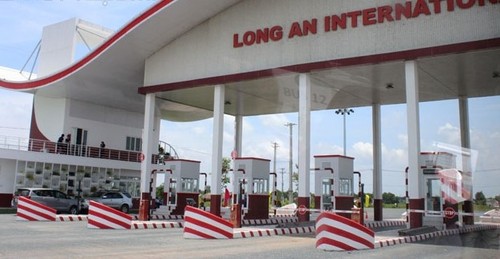 Gemalink international port (Photo: VNA) Gemalink international port (Photo: VNA)
|
Green ports in Vietnam are measured against six criteria – green port perception, resource usage, environmental quality management, energy use, IT application, and emission reduction and response to climate change and rising sea levels. A port must meet 60% of all criteria to be considered a green port.
In 2018, Tan Cang-Cat Lai Terminal in HCMC was the first seaport in Vietnam to receive the Green Port Award by the APEC Ports Service Network (APSN) Council.
This is Vietnam’s largest and most modern international container port, with a total area of 160 hectares of yards, more than 2,000 meters of berth, loading and unloading equipment, and advanced management technology. It ranks among the top 21 large, modern container ports in the world.
In 2021, Tan Cang-Cai Mep International Terminal in Ba Ria-Vung Tau province became the second seaport in Vietnam to receive the Green Port Award.
Gemalink International Port, part of the Cai Mep-Thi Vai port cluster, is another role model in "greenification".
Do Cong Khanh, Gemalink’s Chairman, said his company is equipped with the most modern technology available today, including 8 STS cranes from South Korea and 24 e-RTG cranes, all using grid electricity, operated semi-automatically, integrated with flexible control technology and smart control cabins, and synchronized with modern port management software. Gemalink has attracted shipping lines by meeting green development criteria for reducing environmental impacts.
According to Bui Van Quy, Chairman of the Southeast Asia Seaport Association, the shipping industry makes up about 3% of the world’s greenhouse gas emissions producing 940 million tons of CO2 annually. Therefore, developing seaports in line with green criteria is mandatory.
 At Long An international port (Photo: Nguyen Vy) At Long An international port (Photo: Nguyen Vy)
|
But greenifying seaports in Vietnam is facing difficulties due to restrictions in investment in infrastructure for environmental protection, prevention and response to incidents in maritime activities at seaports.
To address the issue, Pham Thi Bich Hue, President of the Western Pacific Group, said that the Government’s basic investment orientation is to attract investors in factories and systems and then attract shipping lines.
“Connecting localities in the region through seaports is very important, not just for importing and exporting goods. I think investment in seaport infrastructure needs the involvement of individual investors, foreign enterprises, and the Government," said Hue.
Connecting the green seaport system and the water transportation system will also promote freight transport in Vietnam.
After 8 years in operation, Long An International Port has achieved many breakthroughs in waterway transport, asserting itself as the region's focal point for importing and exporting goods, expanding inland waterway corridors, and connecting coastal economies with the southwestern provinces.
Vo Quoc Thang, President of Dong Tam Group, said, “The project to build Long An port serves not just Long An province, but the entire Mekong Delta region. In the coming years, we will use the river system to transport goods throughout the Mekong Delta region, helping businesses in the region reduce production costs.”
Ho Thi Thanh Hoa, Director of the Vietnam Logistics Research and Development Institute, has called on provinces and cities with seaports to study port models around the world, enhance maritime connectivity, and complete the digital transformation of logistics services to better serve customers.